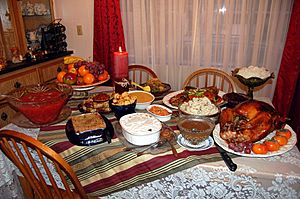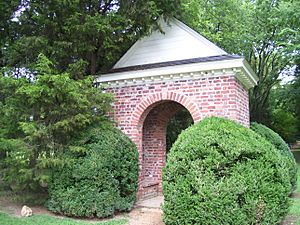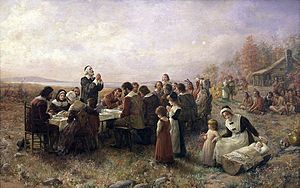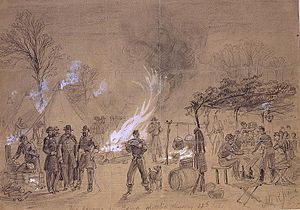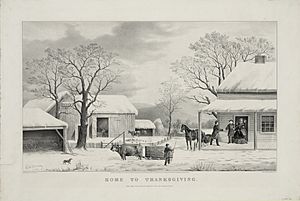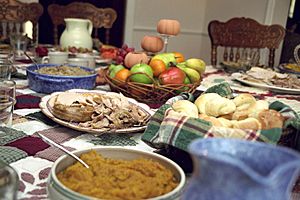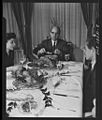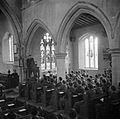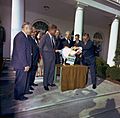Thanksgiving (United States) facts for kids
Quick facts for kids United States Thanksgiving |
|
|---|---|
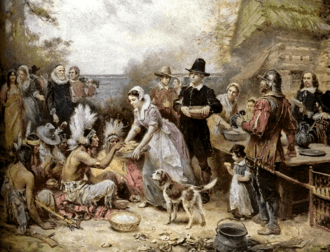
The First Thanksgiving, painting by Jean Leon Gerome Ferris (1863–1930)
|
|
| Observed by | United States |
| Type | National |
| Celebrations | parades, spending time with family, football games, eating large meals |
| Date | fourth Thursday in November |
| 2025 date | November 27, 2025 |
Thanksgiving, also called Thanksgiving Day, is a special holiday in the United States. It happens every year on the fourth Thursday in November. This holiday is a time to say thank you for all the good things in your life. It usually comes at the end of the harvest season.
Most families celebrate by getting together at home. They share a big meal with family or friends. The idea of Thanksgiving comes from old harvest festivals. Many cultures have celebrated these for a very long time. The American holiday also has roots in how Native Americans helped early English settlers. They helped them survive a very hard winter in Plymouth, Massachusetts.
Contents
History of Thanksgiving
Early Thanksgivings by Spanish Settlers
The very first Thanksgiving ceremony happened on September 8, 1565. About 600 Spanish settlers arrived in what is now St. Augustine, Florida. They held a special Mass to thank God for their safe journey. After that, they had a big feast and celebration. Since this area became part of the United States, it is seen as the first Thanksgiving.
Another early Thanksgiving happened in San Elizario, Texas. This town is near El Paso, Texas. On April 30, 1598, a Spanish explorer named Juan de Oñate led his group to rest. They held a special Mass to give thanks. This was not a harvest festival, but it was a day of thanks.
Thanksgiving in the Virginia Colony
In the Colony of Virginia, a group prayer of thanks took place on December 4, 1619. This was led by Captain John Woodlief. It happened near a place called Berkeley Plantation. Even today, people still celebrate there every November. Woodlief told his 38 men that their arrival day in Virginia should always be a holy day of thanks to God.
The Pilgrims' Thanksgiving
The Pilgrims were very thankful to Squanto. He was a Native American who taught them many things. He showed them how to catch eels and how to grow corn. Squanto also helped them talk to other Native Americans. He had learned English when he was a slave in Europe. Without Squanto's help, the Pilgrims might not have lived through their first years.
The Pilgrims held a celebration after their first harvest in 1621. This was at Plymouth. At that time, they did not call it "Thanksgiving." Harvest festivals were already a tradition for both English people and the Wampanoag tribe.
The Pilgrims had a true Thanksgiving in 1623. This was after a long dry period. They prayed for rain, and then it rained! After this, they had a day of thanks. In Plymouth, a Thanksgiving day was usually a church service. It was not always a big feast.
Over time, an annual Thanksgiving after the harvest became common. This started in the mid-1600s. It was not on a set day. Different colonies celebrated on different days.
The Massachusetts Bay Colony first celebrated Thanksgiving in 1630. They did this often until about 1680. Then it became a yearly festival there. Connecticut started in 1639 and celebrated yearly after 1647. The Dutch in New Netherland also had a day of thanks in 1644.
In the 1700s, colonies often had days of thanksgiving. These were usually for military wins or good harvests. They were often days of prayer and fasting, not big meals. In December 1777, the colonies celebrated a Thanksgiving. This was to honor a big victory against the British at Saratoga.
Thanksgiving During the Revolutionary War
During the American Revolutionary War, the Continental Congress asked states to celebrate Thanksgiving days. They did this one or more times each year. The first national Thanksgiving announcement was made by the Continental Congress in 1777.
George Washington, who led the American forces, also called for a Thanksgiving. This was in December 1777. It was to celebrate the defeat of the British at Saratoga.
Thanksgiving in the Early United States
As President, George Washington made the first Thanksgiving Day for the whole country. This was on October 3, 1789. He also called for another Thanksgiving in 1795.
President John Adams declared Thanksgivings in 1798 and 1799. President Thomas Jefferson did not issue any Thanksgiving announcements. But James Madison brought the tradition back in 1814. This was after the War of 1812 ended. Madison also declared the holiday twice in 1815. These early Thanksgivings were not always in the fall.
By 1858, most states and territories had governors who declared a day of Thanksgiving.
Lincoln and the Civil War Thanksgiving
In the middle of the American Civil War, President Abraham Lincoln made Thanksgiving a national holiday. He was encouraged by a writer named Sarah Josepha Hale. Lincoln announced that Thanksgiving would be celebrated on the last Thursday in November 1863.
Since 1863, Thanksgiving has been celebrated every year in the United States.
Changes to the Date (1939-1940)
After Lincoln, other presidents kept the tradition. They declared Thanksgiving on the last Thursday of November. But in 1939, President Franklin D. Roosevelt changed this. That year, November had five Thursdays. Roosevelt declared the fourth Thursday as Thanksgiving.
In 1940, November had four Thursdays. He declared the third one as Thanksgiving. Roosevelt wanted Thanksgiving to be on the second-to-last Thursday. He thought an earlier Thanksgiving would give stores more time to sell things before Christmas. This would help the country during the Great Depression. Back then, advertising for Christmas before Thanksgiving was not common.
Many people did not like this change. Twenty-three states followed Roosevelt's idea. Twenty-two states did not. Some states, like Texas, celebrated both weeks. People called Roosevelt's change "Franksgiving."
Thanksgiving Becomes Law (1941-Present)
In 1941, the United States Congress decided on a fixed date. They passed a law saying Thanksgiving would be on the fourth Thursday of November. This meant it would sometimes be the last Thursday and sometimes the second to last. President Roosevelt signed this law on December 26, 1941. This made the date of Thanksgiving a federal law for the first time.
Since 1947, there has been a fun tradition. The National Turkey Federation gives the President a live turkey and two dressed turkeys. This is called the National Thanksgiving Turkey Presentation. The live turkey is "pardoned." This means it gets to live out its days on a farm. Many people think this tradition started with Harry S. Truman in 1947. But the earliest official record is with George H. W. Bush in 1989. Some stories say it goes back to Abraham Lincoln pardoning his son's pet turkey. Today, two turkeys are usually pardoned, just in case.
Since 1970, some Native Americans and other groups have held a protest. It is called a National Day of Mourning. This happens on Thanksgiving at Plymouth Rock. They do this to raise awareness about social equality.
Traditional Thanksgiving Celebrations
Foods for Thanksgiving Dinner
U.S. tradition connects Thanksgiving with a meal from 1621. This meal was shared by the Wampanoag people and the Puritans in Plymouth Colony. Today, the Thanksgiving dinner is a very important part of the holiday. It often features turkey.
Certain foods are always served at Thanksgiving meals in the United States. The main dish is usually baked or roasted turkey. That is why Thanksgiving is sometimes called "Turkey Day." Other common foods include stuffing, mashed potatoes with gravy, sweet potatoes, cranberry sauce, sweet corn, and other fall vegetables. For dessert, pumpkin pie is very popular. All these main dishes are native to the Americas. Or, they were new foods for Europeans when they arrived. Some vegetarians or vegans eat tofurky. This is a meatless turkey made from tofu.
Many communities have food drives around Thanksgiving. They collect food for people in need. Companies also help by giving out food and Thanksgiving dinners.
Giving Thanks
Thanksgiving started as a religious day. It was a time for everyone in the community to thank God. They gave thanks for things like a good harvest or a safe journey.
Today, people still give thanks in different ways. Churches and other groups have services and events around Thanksgiving. Many families start their Thanksgiving dinner by saying grace. Grace is a prayer said before or after a meal. It is a way to thank God or express appreciation. The custom is shown in the photo "Family Holding Hands and Praying Before a Thanksgiving Meal." The host or hostess might lead the grace. Or, everyone at the table might share what they are thankful for.
Vacation and Travel
On Thanksgiving Day, families and friends gather for a big meal. Because of this, the Thanksgiving holiday weekend is one of the busiest travel times of the year. In the United States, Thanksgiving is a four- or five-day weekend for schools and colleges. Most workers also get Thanksgiving Day and the day after as paid holidays. The night before Thanksgiving, called Thanksgiving Eve, is a very busy night for bars and clubs. Many students come home from college then.
Thanksgiving Parades
In New York City, the Macy's Thanksgiving Day Parade is held every year. It goes from the Upper West Side of Manhattan to the Macy's store in Herald Square. This parade is shown on TV across the country. It has big floats with different themes. There are also scenes from Broadway plays and huge balloons of cartoon characters. High school marching bands also perform. The parade always ends with the Santa Claus float. When Santa arrives, it unofficially means the Christmas season has started.
Many other cities also have Thanksgiving parades, including:
- Chicago, Illinois (McDonald's Thanksgiving Parade)
- Philadelphia, Pennsylvania (6abc IKEA Thanksgiving Day Parade), which claims to be the oldest parade, started in 1920
- Plymouth, Massachusetts (America's Hometown Thanksgiving Parade), held the Saturday before Thanksgiving
- Houston, Texas (H-E-B Holiday Parade)
- St. Louis, Missouri (Ameren St. Louis Thanksgiving Parade)
- Detroit, Michigan (America's Thanksgiving Parade)
- Seattle, Washington
- Fountain Hills, Arizona
- Stamford, Connecticut (UBS Parade Spectacular), held the Sunday before Thanksgiving
- Nicollet Mall, Minneapolis, Minnesota (Target Holidazzle Parades), a series of parades that begin the Friday after Thanksgiving
- Pittsburgh, Pennsylvania (Celebrate the Season Parade)
The Pittsburgh and Minneapolis parades are also supported by Macy's.
Shopping After Thanksgiving
The holiday shopping season in the U.S. traditionally begins the day after Thanksgiving. This day is known as "Black Friday." However, many stores now start selling Christmas items even before Halloween.
Thanksgiving Football
American football is a big part of Thanksgiving in the United States. Professional games are traditionally played on Thanksgiving Day. The National Football League has played games on Thanksgiving every year since it started. This tradition is called the Thanksgiving Classic.
The Detroit Lions have hosted a game every Thanksgiving Day since 1934. The Dallas Cowboys have hosted one every Thanksgiving Day since 1966. Since 2006, three games are played on Thanksgiving Day.
Sometimes, families watch football games on TV during dinner. This can change the holiday mood from a quiet family meal to something like a Super Bowl party. This sometimes makes mothers and others who like old traditions a bit sad.
For many college football teams, their regular season ends on Thanksgiving weekend. Their last game is often against a team they have a long rivalry with. Most of these college games are played on Friday or Saturday after Thanksgiving. But usually, one college game is played on Thanksgiving Day itself.
When is Thanksgiving?
Since 1941, Thanksgiving in the United States is always on the fourth Thursday in November. This means it can be as early as November 22 or as late as November 28. If it falls on November 22 or 23, it is the second to last Thursday, not the very last.
Because it is a Federal holiday, all U.S. government offices are closed. Most financial markets are also closed.
The Friday After Thanksgiving
The Friday after Thanksgiving is not a federal holiday. But many companies give their workers this day off. Most schools are also closed. This Friday is very well known as Black Friday. It gets this name because of the huge amount of shopping that happens. Black Friday is seen as the official start of the Christmas shopping season.
Thanksgiving and Advent
The Thanksgiving holiday also happens around the start of the Advent season. Advent is a four-week period before Christmas in many Christian churches. Advent begins on the fourth Sunday before Christmas Day (December 25). This means Advent starts between November 27 and December 3.
Images for kids
-
"Pilgrims" are sometimes confused with "Puritans". This sculpture The Pilgrim is based on an earlier work called The Puritan.
-
Servicemen eating a Thanksgiving dinner after World War I in 1918.
-
Dr. Mordecai Johnson, president of Howard University, serving Thanksgiving turkey to his family in 1942.
-
John F. Kennedy unofficially spares a turkey on November 19, 1963. This "pardoning" became a regular tradition in 1989.
-
U.S. President George W. Bush visiting Iraq to have Thanksgiving dinner with soldiers in November 2003.
See also
 In Spanish: Día de Acción de Gracias para niños
In Spanish: Día de Acción de Gracias para niños
| U.S. federal holidays |
|---|
| New Year's Day | Martin Luther King, Jr. Day | Presidents' Day | Memorial Day | Independence Day Labor Day | Columbus Day | Veterans Day | Thanksgiving Day | Christmas Day |


